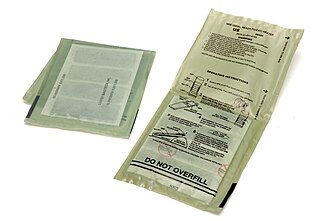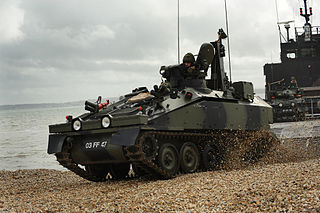
A flameless ration heater (FRH), colloquially an MRE heater, is a form of self-heating food packaging included in U.S. military Meal, Ready-to-Eat (MRE) rations since 1993.

The Centurion was the primary British Army main battle tank of the post-World War II period. Introduced in 1945, it is widely considered to be one of the most successful post-war tank designs, remaining in production into the 1960s, and seeing combat into the 1980s. The chassis was adapted for several other roles, and these variants have remained in service. It was a very popular tank with good armour, mobility, and a powerful main armament.

A beach armoured recovery vehicle (BARV) is an armoured recovery vehicle used for amphibious landings.

A kettle, sometimes called a tea kettle or teakettle, is a device specialized for boiling water, commonly with a lid, spout, and handle. There are two main types: the stovetop kettle, which uses heat from a hob, and the electric kettle, which is a small kitchen appliance with an internal heating element.

The Combat Vehicle Reconnaissance (Tracked), abbreviated CVR(T), is a family of armoured fighting vehicles (AFVs) developed in the 1960s and is in service with the British Army and others throughout the world. They are small, highly mobile, air-transportable armoured vehicles, originally designed to replace the Alvis Saladin armoured car.

The FV101 Scorpion is a British armoured reconnaissance vehicle, and also a light tank. It was the lead vehicle and the fire support type in the Combat Vehicle Reconnaissance (Tracked), CVR(T), family of seven armoured vehicles. Manufactured by Alvis, it was introduced into service with the British Army in 1973 and was withdrawn in 1994. More than 3,000 were produced and used as a reconnaissance vehicle or a light tank.

FV103 Spartan is a tracked armoured personnel carrier of the British Army. It was developed as the APC variant of the Combat Vehicle Reconnaissance (Tracked) family. The vehicle can carry up to seven personnel, including three crew members. Armed with a single machine gun, it is almost indistinguishable from the FV102 Striker in external appearance.

The FV107 Scimitar is an armoured tracked military reconnaissance vehicle formerly used by the British Army, until it was retired from active service in April 2023. It was manufactured by Alvis in Coventry. It is very similar to the FV101 Scorpion, but mounts a high-velocity 30 mm L21 RARDEN cannon instead of a 76 mm gun. It was issued to Royal Armoured Corps armoured regiments in the reconnaissance role. Each regiment originally had a close reconnaissance squadron of five troops, each containing eight FV107 Scimitars. Each Main Battle Tank Regiment also employed eight Scimitars in the close reconnaissance role.

A mess kit is a collection of silverware and cookware designed for use by military personnel for food and military rations. They may also be used during camping and backpacking. There are many varieties of mess kits that militaries issue to their personnel that later become available to consumers.

Hobart's Funnies is the nickname given to a number of specialist armoured fighting vehicles derived from tanks operated during the Second World War by units of the 79th Armoured Division of the British Army or by specialists from the Royal Engineers.

The FV432 is the armoured personnel carrier variant in the British Army's FV430 series of armoured fighting vehicles. Since its introduction in the 1960s, it has been the most common variant, being used for transporting infantry on the battlefield. At its peak in the 1980s, almost 2,500 vehicles were in use.

A field ration is a type of prepackaged military ration designed to be easily and quickly prepared and consumed in the field, in combat, at the front line, or where eating facilities are otherwise unavailable. Field rations are primarily used by military forces, though they are also sometimes distributed to civilians as part of humanitarian aid and emergency management. They differ from garrison rations and field kitchen provisions, which are intended for where proper meals can be supplied and prepared with relative ease and safety, such as in the rear where logistics are steady and fresh food can be supplied. They are similar to, but distinct from, other purpose-designed long-lasting types of food or rations such as emergency rations, humanitarian daily rations, and camping food.

A catastrophic kill, K-Kill or complete kill is damage inflicted on an armored vehicle that renders it permanently non-functional.

The Individual Meal Pack or IMP is one type of field ration used by the Canadian Forces. The IMP is designed so that a continuous diet provides all the nutrition needed to sustain a service-person in the field. The IMP meets Canada's nutrition requirements, with the exception of calcium and folic acid, which are not significant if the consumption period of rations is less than 30 (consecutive) days. IMPs provide 1,200–1,400 calories (5.0–5.9 MJ) per meal.

The Charioteer Tank, or FV4101 Tank, Medium Gun, Charioteer was a post-world-war II British armoured fighting vehicle. It was produced in the 1950s to up-gun units of the Royal Armoured Corps continuing to use the Cromwell tank during the early phases of the Cold War. The vehicle itself was a modified Cromwell with a more powerful gun installed in a relatively lightly armoured two-man turret.

FV 4401 Contentious was a prototype British air-portable tank destroyer of the early 1960s. At least one prototype was constructed and tested, although no production vehicles were built or saw service.

The Benghazi burner or Benghazi cooker was an improvised petrol stove or brazier used by British Army troops and their Commonwealth and Imperial allies in the Second World War, during and after the North African Campaign.
The Norfolk Tank Museum is a collection of armoured fighting vehicles in Norfolk, East England. It is located just outside the village of Forncett St. Peter and 10 miles (16 km) south of the City of Norwich. The collection is made up of mostly British vehicles from the Cold War. The Museum contains around 30 military vehicles as well as a large collection of small arms. It includes the prototype Centurion AVRE 165, the only remaining Crossley-Kégresse 20-30 cwt half-track and a replica British First World War Mark IV that was built for The TV show Guy Martin's WWI Tank.

















